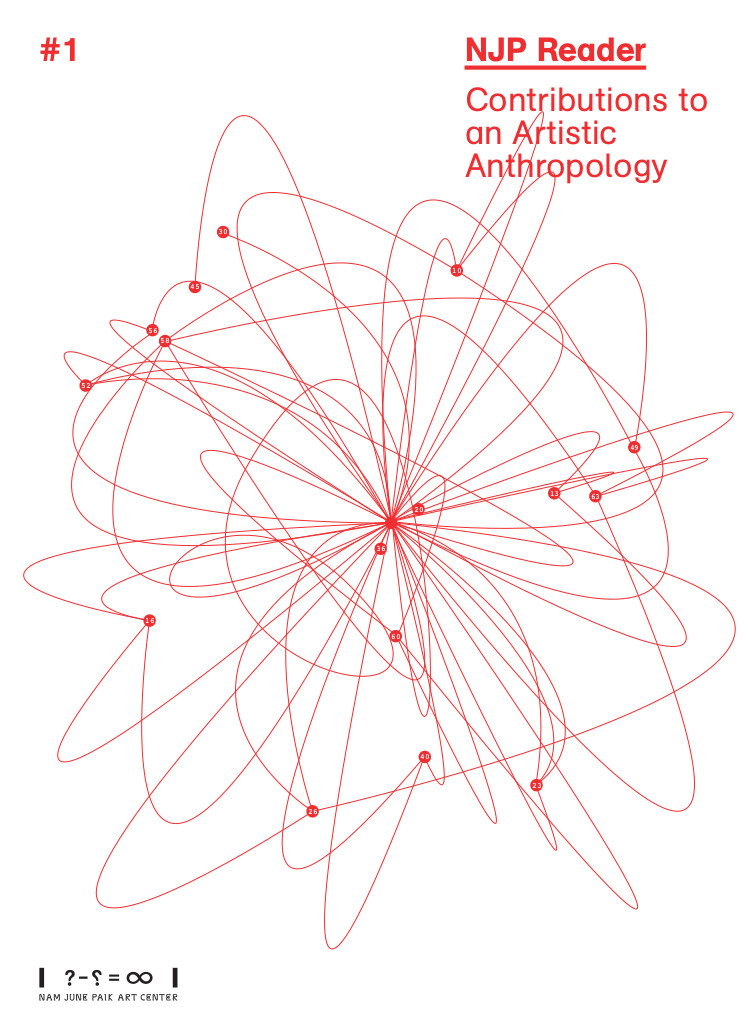NJP Reader #1: Contributions to an Artistic Anthropology (2010) [English, Korean]
Filed under book | Tags: · aesthetics, anthropology, art, contemporary art

“The Nam June Paik Center is dedicated to the artistic and intellectual legacy of Nam June Paik, the renowned Korean-born artist who transformed visual art worldwide. In addition to its function as an exhibition space, the Nam June Paik Art Center developed a new publication, NJP Reader. The aim of the NJP Reader is to recontextualize Nam June Paik’s artistic thought and his ‘random access’ strategies in a topical discursive practice. Leading questions are: What is the meaning of Nam June Paik’s multi-medial experiments, performances, and sculpture for our current artistic practice and discourse? What new dimensions for re-imagining notions of technology, ubiquity, and human experience do Nam June Paik’s thinking and practice suggest? How does his practice potentiate paradigm shifts in broader understandings of the potentialities and characteristics of alternative processes of participation afforded by the introduction of media technology into artistic practice?
Obviously, Nam June Paik’s work requires a conceptual framework that goes beyond an art historical narrative. Therefore, for Issue #1, NJP Reader conducts an inquiry into the novel concept of artistic anthropology in art discourse as an invitation to produce new conceptual systems. The NJP Reader intends to be an open platform for generating novel ideas, connections and concepts (this intention is also reflected in choosing to use Nam June Paik’s initials for its title, rather than his full name). To this aim, the first edition of the NJP Reader is based on a questionnaire that as many artists and intellectuals as possible were invited to contribute responses to. Through this conceptual inquiry the NJP Reader hopes to help in creating novel lines of thought and conceptual schemes. For the questionnaire three questions were formulated:
1. Artistic anthropology intends to produce novel models of relationality and connectivity. Could – Nam June Paik’s legacy as a form of – artistic anthropology contribute to an artistic discourse going beyond the framework of relational aesthetics? Who are the artists in our day developing relevant examples of rethinking and recontextualizing an artistic anthropology?
2. What could artistic anthropology mean for a current artistic practice? How could it relate to medium-specific qualities? Is it a form of artistic communication defined by a post-medium condition? Or is it a practice that demands the concept of medium-specificity to change?
3. What could artistic anthropology – as a form of knowledge production – mean for the current classification system? Will it challenge the dominant paradigms of the established humanities and sciences? What type of new models might this trigger? How can artistic anthropology contribute to a better and more political understanding of the human condition? And what could artistic anthropology mean for the concept of art in general?”
Contributors: Ricardo Basbaum, Jean-Paul Fargier, Ranjit Hoskote and Nancy Adajania, Jeongwhan Jo, Clara Kim, Lev Manovich, Arjen Mulder, Simon O’Sullivan, Wongil Park, John Rajchman, Susanne Rennert, Szabolcs KissPál, Peter Weibel, Haegue Yang, Hiroshi Yoshioka, David Zerbib.
Editors: Youngchul Lee, Henk Slager
Final Editor: Annette W. Balkema
Publisher: Nam June Paik Art Center, Korea, 2010
ISSN 2092-9315
68 pages
PDF (English, updated on 2012-11-19)
PDF (Korean, updated on 2012-11-19)
Tom Apperley: Gaming Rhythms: Play and Counterplay from the Situated to the Global (2010)
Filed under book | Tags: · australia, computer games, everyday, game studies, gaming, life, venezuela

Global gaming networks are heterogenous collectives of localized practices, not unified commercial products. Shifting the analysis of digital games to local specificities that build and perform the global and general, Gaming Rhythms employs ethnographic work conducted in Venezuela and Australia to account for the material experiences of actual game players. This book explores the materiality of digital play across diverse locations and argues that the dynamic relation between the everyday life of the player and the experience of digital game play can only be understood by examining play-practices in their specific situations.
Publisher: Institute of Network Cultures, Amsterdam 2010
Theory on Demand series, No 6
ISBN: 978-90-816021-1-2
Licensed under the Creative Commons Attribution Noncommercial No Derivative Works 3.0 Netherlands License
Image, Time and Motion: New Media Critique from Turkey (2011)
Filed under book | Tags: · 2000s, critique, film, internet, narrative, net criticism, new media, technology, turkey, virtual reality

This reader is a collection of essays written by Turkish graduate students between 2003 and 2010 for Andreas Treske’s seminar ‘Image, Time and Motion’ at Bilkent University in Ankara, revised and actualized in 2010. Coming from a wide range of disciplines they had studied before, very rarely media or cultural studies, these students brought in their various viewpoints and methods, and tried to integrate their observations and understandings in a seminar related to cinema and new media to discuss and sometimes just to describe the influences of digital media technologies for themselves and their colleagues. Starting from the premise that digital technology redefines our moving image culture, the authors reflect in their essays various kind of approaches and methods, experiences and practices, descriptive, critical and interdisciplinary.
Contributors: Pelin Aytemiz, Bestem Büyüm, I. Alev Degim, Bilge Demirtas, Fulya Ertem, Deniz Hasirci, Cagri Baris Kasap, Zeynep Kocer, Rifat Süha Kocoglu, Leyla Önal, Ufuk Önen, Didem Özkul, Segah Sak, Ayda Sevin, Umut Sumnu, Andreas Treske and Funda Senova Tunali.
Edited by: Andreas Treske, Ufuk Onen, Bestem Büyüm and I. Alev Degim
Publisher: Institute of Network Cultures, Amsterdam 2011
Theory on Demand series, No 7
ISBN: 978-90-816021-5-0
146 pages

